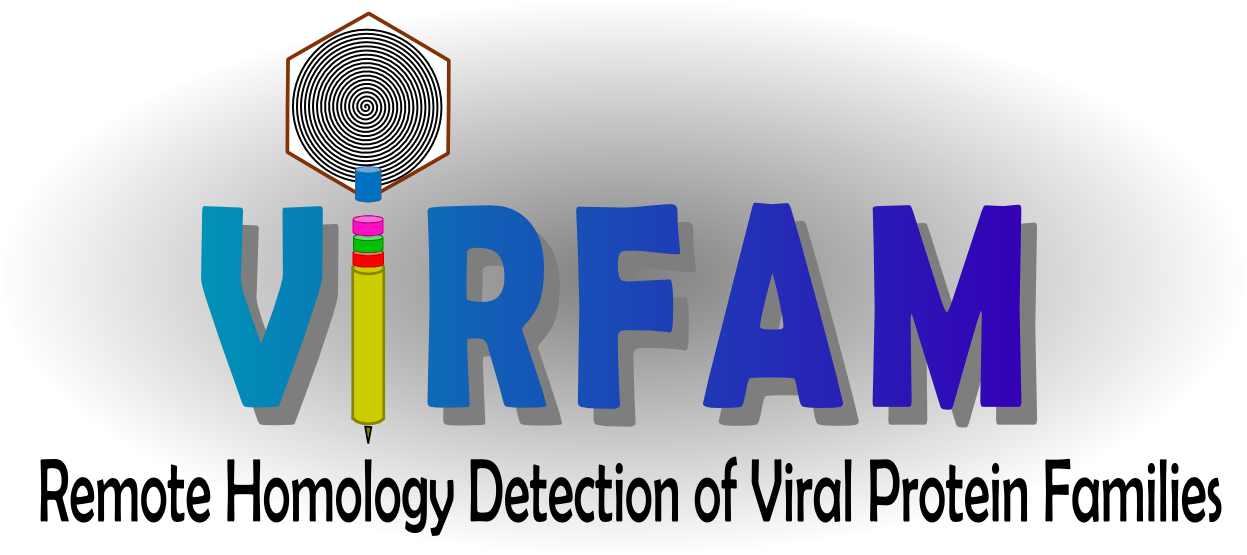
VIRFAM: Supplementary informations
- If you find this server useful for head-neck-tail module search please cite :
Lopes A, Tavares P, Petit MA, Guérois R, Zinn-Justin S. Automated classification of tailed bacteriophages according to their neck organization. BMC Genomics. (2014) 15:1027. doi: 10.1186/1471-2164-15-1027.
- If you find this server useful for recombinases search please cite :
Lopes A, Amarir J, Faure G, Petit M-A, Guerois R. Detection of novel recombinases in bacteriophage genomes unveils Rad52, Rad51 and Gp2.5 remote homologs. Nucleic Acids Res. (2010) 38(12):3952-62.Pubmed
http://toolkit.tuebingen.mpg.de/hhpred
http://en.wikipedia.org/wiki/HHpred_/_HHsearch
please cite : Söding J (2005). "Protein homology detection by HMM-HMM comparison". Bioinformatics 21 (7): 951-960. Pubmed
Profiles are built using the PSI-BLAST algorithm on the nr database filtered to remove sequences with identities above 70%:
Altschul, S.F., Madden, T.L., Schaffer, A.A., Zhang, J., Zhang, Z., Miller, W. and Lipman, D.J. (1997) "Gapped BLAST and PSI-BLAST: a new generation of protein database search programs". Nucleic Acids Res, 25, 3389-3402. Pubmed
The ACLAME database was used to analyze bacteriophage genomes and organize our profile database.
http://aclame.ulb.ac.be/
Leplae R, Lima-Mendez G, Toussaint A. ACLAME: a CLAssification of Mobile genetic Elements, update 2010. Nucleic Acids Res. 2010 Jan;38(Database issue):D57-61. Pubmed
Graphics were generated using the MatPlotLib library
Tree representations were generated using the Environment for Tree Exploration (ETE)
Huerta-Cepas J, Dopazo J, Gabaldon T "ETE: a python environment for Tree Exploration" BMC Bioinformatics, (2010) 11:24 Pubmed
The filtering of the nr database was achieved using the CD-Hit algorithm.
Weizhong Li & Adam Godzik "Cd-hit: a fast program for clustering and comparing large sets of protein or nucleotide sequences" Bioinformatics, (2006) 22:1658-9 Pubmed
To better annotate the superfamilies detected and remove false positives, profiles derived from the PFAM database are used:
R.D. Finn, J. Tate, J. Mistry, P.C. Coggill, J.S. Sammut, H.R. Hotz, G. Ceric, K. Forslund, S.R. Eddy, E.L. Sonnhammer and A. Bateman "The Pfam protein families database" Nucleic Acids Research (2008) Database Issue 36:D281-D288. Pubmed
Contributors
DSV/iBiTec-S/SB2SM/LBSR (CEA)
INRA: Equipe "Architecture des génomes des bactéries et des bacteriophages"
Version history
- January 29, 2010 : VIRFAM is publicly available.

